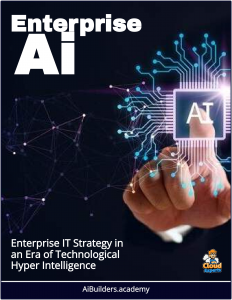 One of the most transformative technologies shaping the future of enterprises today is Artificial Intelligence (AI).
One of the most transformative technologies shaping the future of enterprises today is Artificial Intelligence (AI).
Technology leaders are presented with a uniquely powerful opportunity, and challenge, to incorporate the most disruptive evolution of IT to unlock new opportunities, enhance decision-making processes, and drive unparalleled growth.
AI will redefine the way businesses operate, innovate, and engage with customers. The technology will play a pivotal role in ushering in and driving a new era of digital transformation within enterprise organizations.
The Ai Era
In the annals of human progress, few moments have carried the transformative weight of the era we now inhabit.
The rise of artificial intelligence (AI) is not merely a technological evolution—it is a seismic shift that redefines the boundaries of what enterprises can achieve. For Chief Information Officers (CIOs) and senior executives steering the helm of large organizations, this is both a clarion call and an unprecedented opportunity.
Welcome to Enterprise AI: IT Strategy in an Era of Technological Hyper Intelligence, a guide crafted to illuminate the path forward in a landscape where intelligence itself is becoming a scalable, strategic asset.
We stand at the precipice of a new age—one where AI transcends its role as a tool and emerges as a foundational pillar of business success. The convergence of vast computational power, boundless data, and algorithms capable of learning, reasoning, and adapting at superhuman speed has birthed what we call hyper intelligence.
This is not the AI of science fiction, nor the incremental automation of yesterday. It is a force that amplifies human ingenuity, reshapes operational paradigms, and reconfigures competitive landscapes with breathtaking velocity.
For the enterprise, the stakes could not be higher. Organizations that harness AI effectively will unlock efficiencies, insights, and innovations that were once unimaginable, while those that falter risk obsolescence in a world that waits for no one. Yet, the journey to AI mastery is not without its complexities. It demands a bold reimagining of IT strategy—one that aligns cutting-edge technology with the timeless imperatives of business value, resilience, and ethical stewardship.
This book is your compass in this uncharted territory. Designed for the CIO and the C-suite, it offers a high-level exploration of the AI trends reshaping large enterprises, from intelligent automation and predictive analytics to generative models and beyond.
We will delve into the strategic imperatives that define success: how to architect AI-ready infrastructures, cultivate data-driven cultures, and navigate the governance challenges of a hyper-intelligent future. Through real-world insights, practical frameworks, and a forward-looking lens, we aim to empower you not just to adapt, but to lead.
The era of technological hyper intelligence is not a distant horizon—it is here, now, pulsing through the decisions you make today. This is your moment to seize it, to transform uncertainty into opportunity, and to position your enterprise as a beacon of innovation in a world redefined by AI. Let us begin.
As AI technologies continue to advance, they are reshaping industries, transforming business models, and creating new opportunities for economic growth and prosperity. The integration of AI into sectors such as healthcare, finance, transportation, and manufacturing, is fostering a new wave of efficiency, productivity, and innovation benefits.
As the tide of technological evolution surges forward, we stand at the threshold of a defining epoch—one where artificial intelligence (AI) transcends its role as a mere instrument and emerges as a cornerstone of hyper-intelligent systems.
“Enterprise AI: Enterprise IT Strategy in an Era of Technological Hyper Intelligence” beckons you to embrace this seismic shift, where the fusion of human vision and machine precision redefines the landscape of enterprise IT. In a world awash with data and complexity, AI serves as both architect and navigator, empowering organizations to craft strategies that drive innovation, streamline operations, and outpace the demands of a rapidly changing marketplace.
This book is more than a roadmap; it is a rallying cry for leaders, strategists, and trailblazers poised to wield AI’s extraordinary capabilities and shape an IT future where adaptability is strength, and intelligence is the ultimate competitive edge. Welcome to the era of technological hyper intelligence—where enterprise IT strategy evolves, and the boundaries of possibility are redrawn.
A Roadmap for Enterprise Ai Adoption
Implementing AI in an enterprise setting is a complex endeavor that promises transformative rewards but is fraught with significant challenges. Below, I’ll explore some of the key hurdles organizations face when integrating AI into their IT strategies, particularly in the context of technological hyper intelligence.
1. Data Quality and Availability
AI systems thrive on data—they require vast, diverse, and high-quality datasets to train models and deliver accurate insights. However, enterprises often grapple with fragmented, siloed, or inconsistent data trapped across legacy systems. Poor data governance, incomplete records, or unstructured data (e.g., emails, images, or handwritten notes) can undermine AI performance. The challenge lies in cleaning, standardizing, and integrating this data—a process that demands significant time, resources, and expertise.
2. Infrastructure and Scalability
AI workloads, especially those involving deep learning or real-time analytics, demand robust computational power, often requiring GPUs, cloud platforms, or specialized hardware. Many enterprises rely on outdated IT infrastructure ill-equipped to handle such demands. Scaling AI from pilot projects to enterprise-wide deployment introduces additional complexities, including managing costs, ensuring low latency, and maintaining system reliability under increased loads.
3. Talent and Skill Gaps
AI implementation requires a workforce skilled in data science, machine learning, software engineering, and domain-specific knowledge. Yet, there’s a global shortage of such talent, and competition for experts is fierce. Beyond hiring, organizations must upskill existing employees to work alongside AI systems, fostering a culture of collaboration between humans and machines—a transition that can meet resistance or require extensive retraining efforts.
4. Integration with Legacy Systems
Many enterprises operate on legacy IT architectures—decades-old systems not designed for AI’s dynamic, data-intensive nature. Integrating AI into these environments can be like retrofitting a steam engine with a jet turbine: technically feasible but riddled with compatibility issues, security vulnerabilities, and performance bottlenecks. This often necessitates costly overhauls or middleware solutions, complicating timelines and budgets.
5. Ethical and Governance Concerns
As AI systems make decisions impacting customers, employees, and operations, ethical questions arise: How do we ensure fairness, transparency, and accountability? Bias in training data can lead to skewed outcomes, while opaque “black box” models erode trust. Regulatory compliance (e.g., GDPR, CCPA) adds another layer, requiring enterprises to balance innovation with legal and ethical obligations—a tightrope walk demanding robust governance frameworks.
6. Change Management and Cultural Resistance
AI often disrupts established workflows, threatening job roles or requiring new ways of working. Employees may fear replacement or distrust AI-driven decisions, leading to pushback. Successful implementation hinges on change management—communicating AI’s value, aligning it with organizational goals, and fostering a culture that embraces rather than resists technological hyper intelligence.
7. Cost and ROI Uncertainty
AI projects can be expensive, with upfront costs for technology, talent, and data preparation often dwarfing initial estimates. Meanwhile, the return on investment (ROI) isn’t always immediate or predictable, especially for exploratory initiatives. Enterprises must justify these expenditures to stakeholders while navigating the risk of sunk costs if projects fail to scale or deliver expected outcomes.
8. Security and Privacy Risks
AI systems, with their reliance on vast datasets, become prime targets for cyberattacks. A breach could expose sensitive data or allow adversaries to manipulate AI models (e.g., through adversarial attacks). Ensuring end-to-end security—across data pipelines, model training, and deployment—requires sophisticated safeguards, often beyond the scope of traditional IT defenses.
9. Defining Clear Use Cases
Not every problem needs an AI solution. Enterprises sometimes adopt AI for its buzz rather than its fit, leading to misaligned projects that fail to deliver value. Identifying high-impact use cases—where AI can solve specific pain points or unlock strategic advantages—requires deep business insight and a disciplined approach to prioritization.
10. Maintaining and Evolving AI Systems
AI isn’t a “set it and forget it” technology. Models degrade over time as data patterns shift (a phenomenon called model drift), necessitating continuous monitoring, retraining, and refinement. Enterprises must build processes to maintain AI systems, adapt them to changing conditions, and ensure they remain aligned with evolving business needs—a long-term commitment often underestimated at the outset.
Overcoming the Challenges
Addressing these hurdles requires a strategic approach: starting small with pilot projects to build momentum, investing in data infrastructure and talent development, fostering cross-functional collaboration, and embedding ethics and security into the AI lifecycle. Leadership must champion a vision where AI amplifies human potential, not just technological capability, ensuring that the enterprise thrives in this era of hyper intelligence.
These challenges, while daunting, are not insurmountable. They represent the growing pains of a paradigm shift—one where the rewards of AI-driven transformation can redefine what’s possible for enterprises willing to navigate the complexities.



